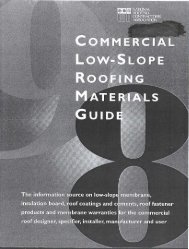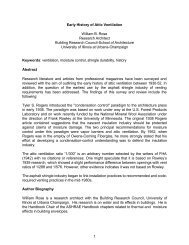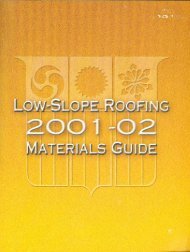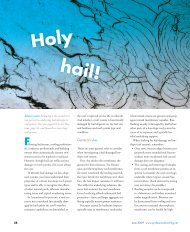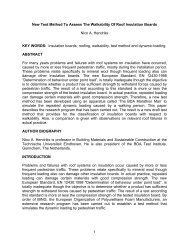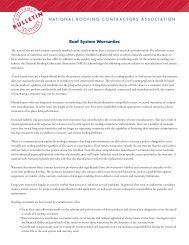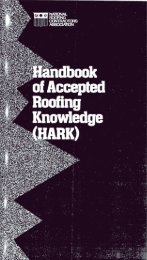! j I I - National Roofing Contractors Association
! j I I - National Roofing Contractors Association
! j I I - National Roofing Contractors Association
- No tags were found...
Create successful ePaper yourself
Turn your PDF publications into a flip-book with our unique Google optimized e-Paper software.
1 Th . k millimeters.. IC nessTh11 2Te'tIt' 'Ith ere atl IP0ICne toac pIn12 46Wtt.7Wtbt' 9FttgthP ,.MdI sorp Ion , pol' c con ytyp romml for of mraar s toasmas fin momPhys sh msIS aemt (es rsThe following is list of twelve basic material properties Significance of the reported physical properties that8D' RIt~tItdth Imen sSPRl's Technical.Itb'l.t aI' fitht. accea era I YI. e wea erm 'Committee has identified as being per- membranerel1l1ass IcaIS ,Tht " e WIICne 'k.IdI'Idmaterialsetc..)IIhḋddf, pemve t toquICne y Itcpumt aIt autI- e fau m0a retinent to all roofing membranes, regardless of chemical com- 1. Thickness The distance between opposite surfaces aposition.material. Units of measure are mils, fractions an inch, I h. f h' k I c '3 Ult nsl e rengt , I I d b ' I bl ' h ' kIma e e onga f 30 ' I 160 ' I ' ,5. T o u us, t nificant variance may be accounted by such factors theear resls ance 'a er vapor ransmlsslon rate ", .. ac ory seam ren ' h h ~ ' f h 'c h ' kw- empera ure resls ance ' , ,. esu a er ea aging , d ' h b h. k .,mechanIcal damage, hall, traffic, and surface wear, althoughTest Procedures for Evaluation of Materials there are certainly other fact?rs, such as compressibility ofTh t t th d d t I t h f h rt ' the substrate, that also contrIbute to all of these, In othere es me 0 s use 0 evauae eac 0 t ese prope les ' ,.d d th h . I ' t ' d words, the susceptibIlity of a membrane to damage does not'vary epen mg upon e c emlca composl Ion an construc- . "ent, esu 't m t10 Lo t tt ' f th fi . h d b D '= h d m any way rely soley on the thIckness of the materIal.Ion 0 e mls e mem rane. IIIerent test met 0 s areused for different generic types of material, as well as for rein- 2. Tensile strength The maximum force of stress requiredforced and nonreinforced membranes.to break a membrane sample. For nonreinforced membrcines,To understand the results reported by manufacturers, it is strength is reported as a stress (pounds per square inch, orimportant to know the test methods from which the data are "psi"); for reinforced membranes, strength is reported as aderived, Frequently, attempts are made to compare the test force (pounds, or "lbf'),results of different products to try to draw conclusions about This physical property relates to the ability of a membranetheir relative performance capabilities. Often the conclusions to withstand stresses that might be imposed by such thingsdrawn are invalid because the comparison is of data obtained as building movement, wind uplift, and thermal loading. Theusing different test methods, Sometimes a particular test presence of reinforcing material and the type of material usedmethoois preferred for a particular generic membrane type. as reinforcement may also affect tensile strength.Inble;otherthecases,selectionthereofarewhichmultipetotestsusethatis madeare equallyby individualapplica-3. Ultimate.~longatl?n.T?e amount, a membrane samplemanufacturuers based on such factors as availablility of neces- stretches durIng tensIle testing bef~r~ It ruptures, usually exsarytesting equipment or apparatus. Some testing may be pressed as a ~ercentage of the orIgInal len~h, , ,performed by independent laboratories, while other tests are ,The elongation of a membra~e may contrIbute to ItS abllroutinelyperformed by the manufacturer in-house.Itr to accommo?ate move~ent m the substrate or struct~reIn most cases, standard test methods are available, These wIthout r~p~urmg, There IS a broad range ?f elongationare established by the American Society for Testing and v,alues exhIbIted by products that are ap.proprlate for use asMaterials (ASTM), There are also other agencies worldwide sIngle-ply roofing membran~s, The varl,a,nce from pro?uctthat define testing methods for single-ply membranes that may to product dep~nds on,chem~cal comp~sltlon and sometimesbe similar to, but not exactly the same as, the ASTM methods. o~ the i;>resence ?f remforcmg,materlals, In some c~ses, aSome of these agencies utilize ad hoc procedures that may rem~orcmg mat~rlal may brea~ Internally at a low stram levbedifficult to duplicate or that do not differentiate between ~l wIthout affectln~ the IntegrIty of the sh~et, t~ereby all?w-~neric membrane types. If physical property data are to be mg the membrane Itself to stre~ch and achIeve I~S e~ongatl?nused to aid in product selection, the test methods should also property. In oth~r cases, t~e remforc~ment has a,hl.gh resIstbeconsidered. Sometimes the difference in test method ac- an~e to elongation a?d Imparts thIs c?aracterlstlc to ~hecounts for the difference in the articular results re orted.p pfinIshed sheet, prod~cm~ a membrane wIth a low elongatlo,nproperty, The selection IS made by the manufacturer and ISTest Methodsbased largely on the manner in which the material will beMuch work is currently being done by ASTM in the area of installed,standards for ~ingle-ply roofing membranes, and it is expected 4. Modulus Modulus is a meausre of the stiffness of a polythatstandard test methods and minimum material property meric sheet, Since polymeric materials do not exhibit tradivalueswill be developed for the vulcanized elastomers EPDM tional elastic behavior over their entire range of elongation,and neoprene and the thermoplastic PVC, Another ASTM the modulus is not a constant; rather it is reported as thegroup is addressing the testing of modified bitumen memo tensile stress required to produce a prescribed elongation.branes. Historically, however, these products have not had When the modulus at 50% elongation is reported for a numstandardASTM procedures that were designed specifically ber of products, it allows for a comparison of their relativefor them as opposed to built-up bituminous roofing membranes,Therefore, the test procedures for these materials arestiffness. This is expressed as psi at a given percent elongation,The presence of reinforcement affects the modulus of ain the development stage, The Modified Bitumen Sub- material by significantly increasing its stiffness; it may alsoCommittee of SPRl's Technical Committee has developed affect the elongation properties in the direction of the reinnewand/or adapted existing ASTM methods that it feels best forcing medium. Like elongation, this property is an indicaevaluatethe physical characteristics of these products, tor of the suitability of the formulation for use as a roofingmembrane, but is not a direct predictor of its performance~ _.- . - .. -17


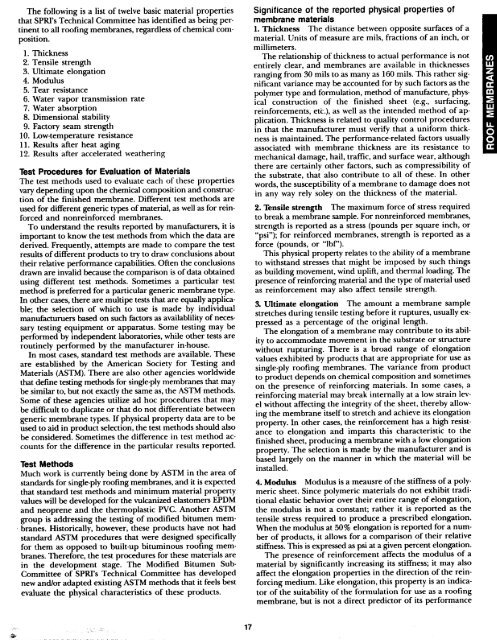

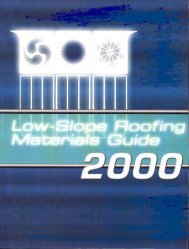
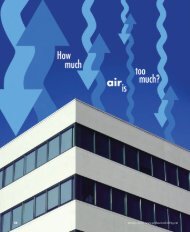
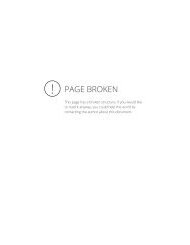
![Wm] - National Roofing Contractors Association](https://img.yumpu.com/36696816/1/190x245/wm-national-roofing-contractors-association.jpg?quality=85)

